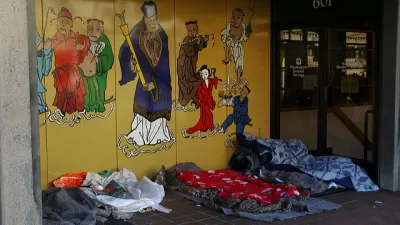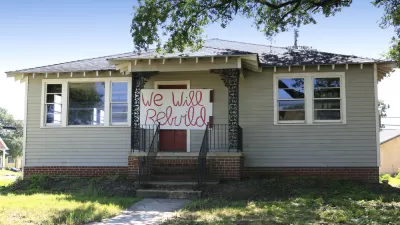New Orleans Mayor Ray Nagin has a new solution for the homeless people living in the tent city near the French Quarter: Move them into barracks.
"[New Orleans Mayor Ray] Nagin vowed to use health and safety codes to move the men and women living underneath the stretch of Interstate 10 known as the Claiborne Avenue bridge to the tarp-covered facility that was awaiting fire inspections. Aware of the camp's proximity to the French Quarter and other tourist destinations, the mayor wants the move done by the end of the week."
"The barrack, 120-feet long and 30-feet wide, is air-conditioned, filled with double-decker bunk beds and stands on the grounds of a mission in the city's Central Business District that has worked with the homeless for 20 years...[but critics say the] military-style barrack is short on long-term solutions to a homeless epidemic."
"But even its administrator said he is unsure the facility that offers only meals and overnight stays to about 120 people can really help a homeless population that has doubled to 12,000 since Katrina struck in August 2005. The city's public advocacy unit, unarmed officers with the New Orleans Police Department Homeless Assistance Collaborative, city housing department workers, and mission staff will usher people into the barrack as early as Thursday, Quiett said. Those who do not go elsewhere will face citations, and arrests could take place if drugs are found, city officials said."
"The encampment attracted former Sen. John Edwards, who stopped there the day he ended his presidential bid and pledged to "never forget" the downtrodden. Visiting pro athletes have handed out food there on the way to the New Orleans Arena and Louisiana Superdome a few blocks away."
"Countless tourists also have passed the spectacle of curbside panhandlers, frayed camping tents, scattered sleeping bags, discarded home furnishings that stretches for about five city blocks not a half-mile from the French Quarter."
FULL STORY: New Orleans homeless pushed into barrack

Planetizen Federal Action Tracker
A weekly monitor of how Trump’s orders and actions are impacting planners and planning in America.

Restaurant Patios Were a Pandemic Win — Why Were They so Hard to Keep?
Social distancing requirements and changes in travel patterns prompted cities to pilot new uses for street and sidewalk space. Then it got complicated.

Maui's Vacation Rental Debate Turns Ugly
Verbal attacks, misinformation campaigns and fistfights plague a high-stakes debate to convert thousands of vacation rentals into long-term housing.

In California Battle of Housing vs. Environment, Housing Just Won
A new state law significantly limits the power of CEQA, an environmental review law that served as a powerful tool for blocking new development.

Boulder Eliminates Parking Minimums Citywide
Officials estimate the cost of building a single underground parking space at up to $100,000.

Orange County, Florida Adopts Largest US “Sprawl Repair” Code
The ‘Orange Code’ seeks to rectify decades of sprawl-inducing, car-oriented development.
Urban Design for Planners 1: Software Tools
This six-course series explores essential urban design concepts using open source software and equips planners with the tools they need to participate fully in the urban design process.
Planning for Universal Design
Learn the tools for implementing Universal Design in planning regulations.
Heyer Gruel & Associates PA
JM Goldson LLC
Custer County Colorado
City of Camden Redevelopment Agency
City of Astoria
Transportation Research & Education Center (TREC) at Portland State University
Camden Redevelopment Agency
City of Claremont
Municipality of Princeton (NJ)





























